
RÉSUMÉ EN ANGLAIS
AERODYNAMICS OF FLIGHT
INTRODUCTION
Thrust, drag, lift, and weight are forces that act upon all aircraft in flight. Understanding how these forces work and knowing how to control them with the use of power and flight controls are essential to flight.
The four forces acting on an aircraft in straight-and-level, unaccelerated flight are thrust, drag, lift, and weight. They are defined as follows:
- Thrust — the forward force produced by the powerplant/ propeller or rotor. It opposes or overcomes the force of drag. As a general rule, it acts parallel to the longitudinal axis. However, this is not always the case.
- Drag — a rearward, retarding force caused by disruption of airflow by the wing, rotor, fuselage, and other protruding objects. As a general rule, drag opposes thrust and acts rearward parallel to the relative wind.
- Lift — is a force that is produced by the dynamic effect of the air acting on the airfoil, and acts perpendicular to the flight path through the center of lift (CL) and perpendicular to the lateral axis. In level flight, lift opposes the downward force of weight
- Weight — Gravity is the pulling force that tends to draw all bodies to the center of the earth. The CG may be considered as a point at which all the weight of the aircraft is concentrated. If the aircraft were supported at its exact CG, it would balance in any attitude. It will be noted that CG is of major importance in an aircraft, for its position has a great bearing upon stabilite.
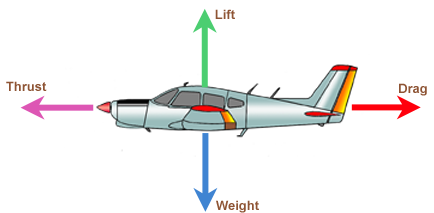
The lift and drag forces are the direct result of the relationship between the relative wind and the aircraft. The lift force always acts perpendicular to the relative wind and the drag force always acts parallel and in the same direction as the relative wind. These forces are actually the components that produce a resulting lift force on the wing.
Angle of Attack (AOA)
The chord of an airfoil or wing section is an imaginary straight line that passes through the section from the leading edge to the trailing edge. The chord line provides one side of an angle that ultimately forms the AOA. The other side of the angle is formed by a line indicating the direction of the relative airstream. Thus, AOA is defined as the angle between the chord line of the wing and the direction of the relative wind. This is not to be confused with the angle between the chord line of the wing and the longitudinal axis of the aircraft.
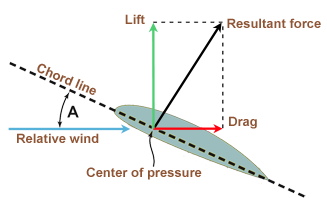
Lift
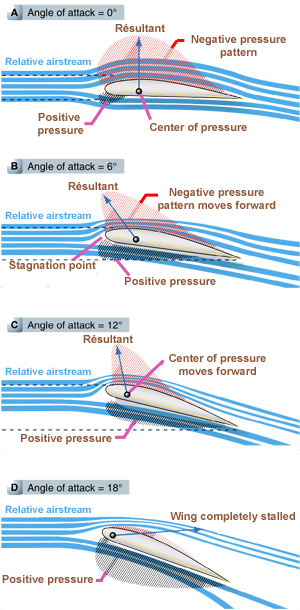 |
Weight has a definite relationship to lift. This relationship is simple, but important in understanding the aerodynamics of flying. Lift is the upward force on the wing acting perpendicular to the relative wind. Lift is required to counteract the aircraft’s weight (which is caused by the force of gravity acting on the mass of the aircraft). In stabilized level flight, when the lift force is equal to the weight force, the aircraft is in a state of equilibrium and neither gains nor loses altitude. If lift becomes less than weight, the aircraft loses altitude. When lift is greater than weight, the aircraft gains altitude. The pilot can control the elevator. Each time the handle or handle is moved forward or backward, the angle of attack is changed. The greater the angle of attack, the greater the lift (all other factors being equal). When the aircraft reaches the maximum angle of attack, the lift begins to decrease rapidly. This is the critical angle of attack at stall, called the CL-MAX critical angle of attack. Examine the figure opposite, noting how the LC increases until the critical angle of attack is reached, then decreases rapidly with any further increase in the angle of attack. |
Drag
The total drag of an aircraft is composed of many drag forces, but only three will be studied: parasitic drag, profile drag and induced drag.
When an airfoil is flown at a positive AOA, a pressure differential exists between the upper and lower surfaces of the airfoil. The air on the upper surface has a tendency to flow in toward, and the air on the underside tends to flow towards the tip of the wing.
When the respective flows of the lower and upper surface eventually meet at the trailing edge of the wing, they cross each other and form small (very small) vortices downstream of the wing
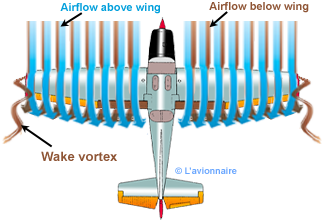
Since air always moves from high pressure toward low pressure, and the path of least resistance is toward the airfoil’s tips, there is a spanwise movement of air from the bottom of the airfoil outward from the fuselage around the tips. This flow of air results in “spillage” over the tips, thereby setting up a whirlpool of air called a “vortex.”
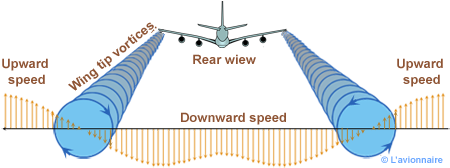
The intensity or strength of the vortices is directly proportional to the weight of the aircraft and inversely proportional to the wingspan and speed of the aircraft. The heavier and slower the aircraft, the greater the AOA and the stronger the wingtip vortices. Thus, an aircraft will create wingtip vortices with maximum strength occurring during the takeoff, climb, and landing phases of flight.
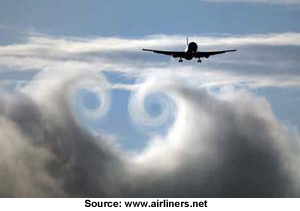
The different angles
- Ø flight attitude is the angle between the axis of the fuselage and the horizontal.
- γ slope ou "flight path angle" is the angle between the horizontal and the speed axis.
- AoA (Angle of attack) angle formed between the longitudinal axis of the aircraft and the relative wind direction (speed axis).

Note : AoA
The angle of attack is defined in relation to the axis of the aircraft and not in relation to the wing. To reduce drag in cruise, the wing forms an angle with the axis of the aircraft. It is the angle between the chord of the wing profile and the longitudinal axis of the aircraft.
This angle is called the angle of incidence.
![]()
